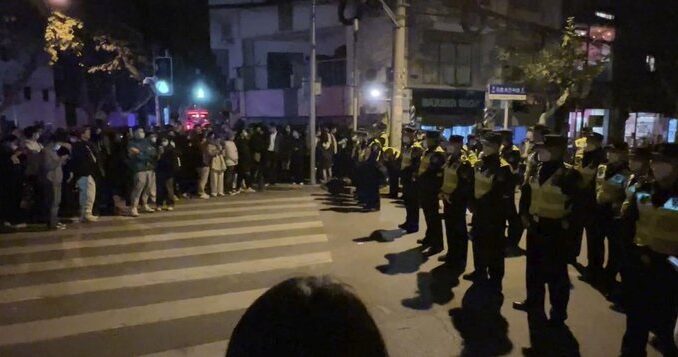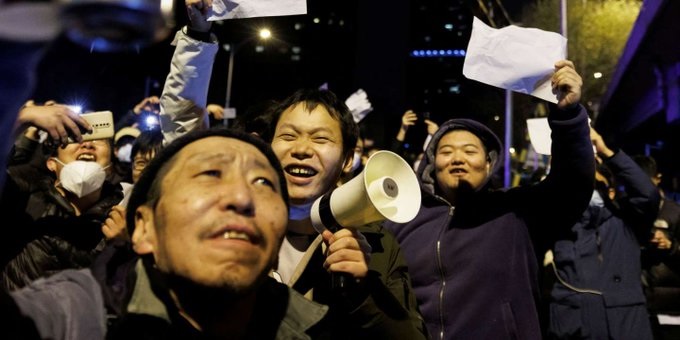
“People across China are taking extraordinary risks to demand their human rights,” said Yaqiu Wang, senior China researcher at Human Rights Watch.
Unprecedented Nationwide Demonstrations Demand Freedoms
(New York) – The Chinese government should respect the fundamental rights of people across China to peacefully protest the government’s draconian “zero Covid” restrictions and to call for freedom and human rights, Human Rights Watch said today. The authorities should immediately release all protesters wrongfully detained and cease online censorship of protest-related information.
On November 26, 2022, thousands of people in Shanghai, China’s biggest city and financial center, began publicly protesting the government’s strict Covid-19 measures and denouncing the Chinese Communist Party’s authoritarian rule. Demonstrators held blank banners – to evade arrest and minimize risk – and chanted slogans such as “Down with Communist Party!” and “Down with Xi Jinping!”, the country’s leader. On November 27, university students across the country gathered on their campuses to demonstrate, and that night, hundreds of people in Wuhan, where Covid-19 originated, Chengdu, Beijing, and other large cities, took to the streets.
“People across China are taking extraordinary risks to demand their human rights,” said Yaqiu Wang, senior China researcher at Human Rights Watch. “The Chinese authorities should not suppress the protests but instead allow everyone to peacefully express their views.”
The protest in Shanghai was in response to a November 24 fire at an apartment building in Urumqi, the capital of China’s northwest Xinjiang region, in which at least 10 people were killed. Many people suspected, though Human Rights Watch could not confirm, that residents were prevented from escaping the blaze due to pandemic control barriers, and emergency responders were hampered by Covid-related restrictions.
The following day, Urumqi residents gathered in front of a government administration building to mourn the deaths and protest Covid restrictions, which have kept the city under lockdown for over three months. Numerous reports of deaths, illnesses, and hunger due to lack of access to food and medical care in Xinjiang surfaced online.
In Beijing, people gathered under Sitong Bridge, where on the eve of the 20th Communist Party Congress in October a lone protester unfurled banners stating: “Remove that authoritarian traitor Xi Jinping.” Numerous protest banners, posters, and graffiti of unknown origin appeared in public places across the country.
Videos circulated online show dozens of police officers arriving at protest sites in Shanghai and elsewhere, trying to disperse the crowds, and dragging protesters into police vehicles. Shanghai police handcuffed a BBC journalist covering the protest and took him to a police station, where they kicked and beat him. One video shows an unidentified man in plain clothes snatching a lone woman holding a blank piece of paper standing on the steps of the Communication University of China in Nanjing.
Online censors removed social media posts and accounts providing news about the protests. Search functions on social media platforms also made protest-related information hard to find.
While small-scale protests over specific government abuses happen occasionally in China, it is extremely rare for people to publicly call for President Xi Jinping to step down or for the end of Communist Party rule. The authorities punish any perceived challenge to the Party’s hold on power with long prison sentences under highly abusive conditions.

The Chinese government has a history of violently suppressing protests, with the most notable incident being the 1989 Tiananmen Massacre, when military forces killed an untold number of peaceful pro-democracy demonstrators in Beijing. Since then, authorities have cracked down on numerous peaceful protests across the country. In the aftermath of the 2009 protests in Xinjiang, security forces detained hundreds of people on suspicion of participation in the unrest. Dozens of these detainees, and possibly many more, were forcibly disappeared.
In 2011, an online appeal calling for people in China to emulate the Arab Spring uprisings resulted in small gatherings of onlookers in Beijing and several other cities. The authorities reacted by rounding up over 100 of the country’s most outspoken critics, forcibly disappearing them for weeks outside of any legal procedure. For the 2008 and 2022 Beijing Olympics, the authorities agreed to establish designated protest zones. In 2008 one of the few people to try to obtain permission was immediately detained. In 2022 few if any permits were sought.
In recent years, the authorities have tightened online censorship, expanded their use of surveillance technologies, dismantled civil society groups, and imprisoned many independent activists, making large-scale protests extremely difficult to carry out. In recent months there have been sporadic protests over Covid-19 abuses, economic hardship, censorship, and Xi’s expanded powers within China and by Chinese nationals outside the country.
The Chinese government has domestic and international obligations to permit protests and protect the rights of demonstrators. China’s constitution, in article 35, provides that citizens enjoy freedom of “assembly, association, procession and demonstration.” The Universal Declaration of Human Rights, which is considered reflective of customary international law, and the International Covenant on Civil and Political Rights, which China has signed but not ratified, protect the rights to peaceful assembly, as well as freedom of expression and association.
The United Nations Human Rights Committee, in its General Comment No. 37 on the right of peaceful assembly, states that governments must allow peaceful assemblies “to take place without unwarranted interference and to facilitate the exercise of the right and to protect the participants.” Failure to protect this right “is typically a marker of repression.”
Any law enforcement response to the protests must meet international standards. The UN Basic Principles on the Use of Force and Firearms by Law Enforcement Officials states that security forces in carrying out their duty should apply nonviolent means before resorting to the use of force. Where it is required for a legitimate law enforcement purpose during an assembly, only the minimum force necessary may be used. The authorities must also respect the rights of journalists and human rights defenders to monitor and report on assemblies.
Governments and international organizations that speak about human rights in China should express support for people’s rights to free speech and assembly, and urge the Chinese authorities not to suppress the protests, Human Rights Watch said.
“Chinese authorities have badly underestimated the willingness of people across China to risk all to have their rights and liberties respected,” Wang said. “People in China with incredible courage are showing the Chinese Communist Party and the world that they, like everyone else, are entitled to have a say in how they are governed.”
